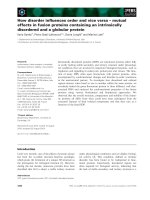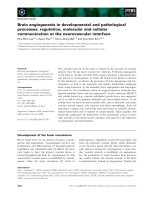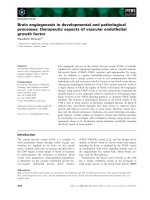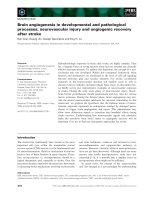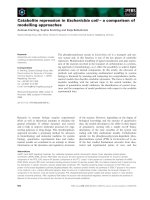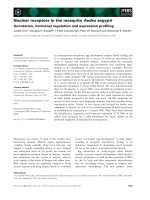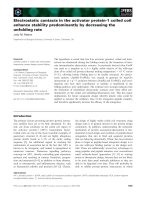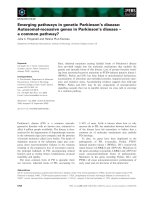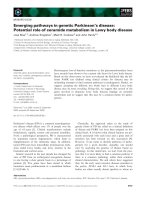Tài liệu Báo cáo khoa học: "Predicting Success in Dialogue" doc
Bạn đang xem bản rút gọn của tài liệu. Xem và tải ngay bản đầy đủ của tài liệu tại đây (123.21 KB, 8 trang )
Proceedings of the 45th Annual Meeting of the Association of Computational Linguistics, pages 808–815,
Prague, Czech Republic, June 2007.
c
2007 Association for Computational Linguistics
Predicting Success in Dialogue
David Reitter and Johanna D. Moore
dreitter | jmoore @ inf.ed.ac.uk
School of Informatics
University of Edinburgh
United Kingdom
Abstract
Task-solving in dialogue depends on the lin-
guistic alignment of the interlocutors, which
Pickering & Garrod (2004) have suggested
to be based on mechanistic repetition ef-
fects. In this paper, we seek confirmation
of this hypothesis by looking at repetition
in corpora, and whether repetition is cor-
related with task success. We show that
the relevant repetition tendency is based on
slow adaptation rather than short-term prim-
ing and demonstrate that lexical and syntac-
tic repetition is a reliable predictor of task
success given the first five minutes of a task-
oriented dialogue.
1 Introduction
While humans are remarkably efficient, flexible and
reliable communicators, we are far from perfect.
Our dialogues differ in how successfully informa-
tion is conveyed. In task-oriented dialogue, where
the interlocutors are communicating to solve a prob-
lem, task success is a crucial indicator of the success
of the communication.
An automatic measure of task success would be
useful for evaluating conversations among humans,
e.g., for evaluating agents in a call center. In human-
computer dialogues, predicting the task success after
just a first few turns of the conversation could avoid
disappointment: if the conversation isn’t going well,
a caller may be passed on to a human operator, or
the system may switch dialogue strategies. As a first
step, we focus on human-human dialogue, since cur-
rent spoken dialogue systems do not yet yield long,
syntactically complex conversations.
In this paper, we use syntactic and lexical features
to predict task success in an environment where we
assume no speaker model, no semantic information
and no information typical for a human-computer
dialogue system, e.g., ASR confidence. The fea-
tures we use are based on a psychological theory,
linking alignment between dialogue participants to
low-level syntactic priming. An examination of this
priming reveals differences between short-term and
long-term effects.
1.1 Repetition supports dialogue
In their Interactive Alignment Model (IAM), Pick-
ering and Garrod (2004) suggest that dialogue be-
tween humans is greatly aided by aligning repre-
sentations on several linguistic and conceptual lev-
els. This effect is assumed to be driven by a cas-
cade of linguistic priming effects, where interlocu-
tors tend to re-use lexical, syntactic and other lin-
guistic structures after their introduction. Such re-
use leads speakers to agree on a common situa-
tion model. Several studies have shown that speak-
ers copy their interlocutor’s syntax (Branigan et al.,
1999). This effect is usually referred to as structural
(or: syntactic) priming. These persistence effects
are inter-related, as lexical repetition implies pref-
erences for syntactic choices, and syntactic choices
lead to preferred semantic interpretations. Without
demanding additional cognitive resources, the ef-
fects form a causal chain that will benefit the inter-
locutor’s purposes. Or, at the very least, it will be
easier for them to repeat linguistic choices than to
808
actively discuss their terminology and keep track of
each other’s current knowledge of the situation in
order to come to a mutual understanding.
1.2 Structural priming
The repetition effect at the center of this paper, prim-
ing, is defined as a tendency to repeat linguistic de-
cisions. Priming has been shown to affect language
production and, to a lesser extent, comprehension, at
different levels of linguistic analysis. This tendency
may show up in various ways, for instance in the
case of lexical priming as a shorter response time in
lexical decision making tasks, or as a preference for
one syntactic construction over an alternative one in
syntactic priming (Bock, 1986). In an experimental
study (Branigan et al., 1999), subjects were primed
by completing either sentence (1a) or (1b):
1a. The racing driver showed the torn overall
1b. The racing driver showedthe helpful mechanic
Sentence (1a) was to be completed with a prepo-
sitional object (“to the helpful mechanic”), while
(1b) required a double object construction (“the torn
overall”). Subsequently, subjects were allowed to
freely complete a sentence such as the following
one, describing a picture they were shown:
2. The patient showed
Subjects were more likely to complete (2) with a
double-object construction when primed with (1b),
and with a prepositional object construction when
primed with (1a).
In a previous corpus-study, using transcriptions
of spontaneous, task-oriented and non-task-oriented
dialogue, utterances were annotated with syntactic
trees, which we then used to determine the phrase-
structure rules that licensed production (and com-
prehension) of the utterances (Reitter et al., 2006b).
For each rule, the time of its occurrence was noted,
e.g. we noted
3. 117.9s NP → AT AP NN a fenced meadow
4. 125.5s NP → AT AP NN the abandoned cottage
In this study, we then found that the re-occurrence
of a rule (as in 4) was correlated with the temporal
distance to the first occurrence (3), e.g., 7.6 seconds.
The shorter the distance between prime (3) and tar-
get (4), the more likely were rules to re-occur.
In a conversation, priming may lead a speaker
to choose a verb over a synonym because their in-
terlocutor has used it a few seconds before. This,
in turn, will increase the likelihood of the struc-
tural form of the arguments in the governed verbal
phrase–simply because lexical items have their pref-
erences for particular syntactic structures, but also
because structural priming may be stronger if lexi-
cal items are repeated (lexical boost, Pickering and
Branigan (1998)). Additionally, the structural prim-
ing effects introduced above will make a previously
observed or produced syntactic structure more likely
to be re-used. This chain reaction leads interlocu-
tors in dialogue to reach a common situation model.
Note that the IAM, in which interlocutors automati-
cally and cheaply build a common representation of
common knowledge, is at odds with views that af-
ford each dialogue participant an explicit and sepa-
rate representation of their interlocutor’s knowledge.
The connection between linguistic persistence or
priming effects and the success of dialogue is cru-
cial for the IAM. The predictions arising from this,
however, have eluded testing so far. In our previous
study (Reitter et al., 2006b), we found more syn-
tactic priming in the task-oriented dialogues of the
Map Task corpus than in the spontaneous conversa-
tion collected in the Switchboard corpus. However,
we compared priming effects across two datasets,
where participants and conversation topics differed
greatly. Switchboard contains spontaneous conver-
sation over the telephone, while the task-oriented
Map Task corpus was recorded with interlocutors
co-present. While the result (more priming in
task-oriented dialogue) supported the predictions of
IAM, cognitive load effects could not be distin-
guished from priming. In the current study, we ex-
amine structural repetition in task-oriented dialogue
only and focus on an extrinsic measure, namely task
success.
2 Related Work
Prior work on predicting task success has been
done in the context of human-computer spoken di-
alogue systems. Features such as recognition er-
ror rates, natural language understanding confidence
and context shifts, confirmations and re-prompts (di-
alogue management) have been used classify dia-
809
logues into successful and problematic ones (Walker
et al., 2000). With these automatically obtainable
features, an accuracy of 79% can be achieved given
the first two turns of “How may I help you?” di-
alogues, where callers are supposed to be routed
given a short statement from them about what they
would like to do. From the whole interaction (very
rarely more than five turns), 87% accuracy can be
achieved (36% of dialogues had been hand-labeled
“problematic”). However, the most predictive fea-
tures, which related to automatic speech recognition
errors, are neither available in the human-human di-
alogue we are concerned with, nor are they likely to
be the cause of communication problems there.
Moreover, failures in the Map Task dialogues are
due to the actual goings-on when two interlocutors
engage in collaborative problem-solving to jointly
reach an understanding. In such dialogues, inter-
locutors work over a period of about half an hour.
To predict their degree of success, we will leverage
the phenomenon of persistence, or priming.
In previous work, two paradigms have seen exten-
sive use to measure repetition and priming effects.
Experimental studies expose subjects to a particular
syntactic construction, either by having them pro-
duce the construction by completing a sample sen-
tence, or by having an experimenter or confederate
interlocutor use the construction. Then, subjects are
asked to describe a picture or continue with a given
task, eliciting the target construction or a compet-
ing, semantically equivalent alternative. The analy-
sis then shows an effect of the controlled condition
on the subject’s use of the target construction.
Observational studies use naturalistic data, such
as text and dialogue found in corpora. Here, the
prime construction is not controlled–but again, a
correlation between primes and targets is sought.
Specific competing constructions such as ac-
tive/passive, verbal particle placement or that-
deletion in English are often the object of study
(Szmrecsanyi, 2005; Gries, 2005; Dubey et al.,
2005; J
¨
ager, 2006), but the effect can also be gen-
eralized to syntactic phrase-structure rules or com-
binatorial categories (Reitter et al., 2006a).
Church (2000) proposes adaptive language mod-
els to account for lexical adaptation. Each document
is split into prime and target halves. Then, for se-
lected words w, the model estimates
P (+adapt) = P (w ∈ target|w ∈ prime)
P (+adapt) is higher than P
prior
= P (w ∈
target), which is not surprising, since texts are usu-
ally about a limited number of topics.
This method looks at repetition over whole doc-
ument halves, independently of decay. In this pa-
per, we apply the same technique to syntactic rules,
where we expect to estimate syntactic priming ef-
fects of the long-term variety.
3 Repetition-based Success Prediction
3.1 The Success Prediction Task
In the following, we define two variants of the task
and then describe a model that uses repetition effects
to predict success.
Task 1: Success is estimated when an entire di-
alogue is given. All linguistic and non-linguistic
information available may be used. This task re-
flects post-hoc analysis applications, where dia-
logues need to be evaluated without the actual suc-
cess measure being available for each dialogue. This
covers cases where, e.g., it is unclear whether a call
center agent or an automated system actually re-
sponded to the call satisfactorily.
Task 2: Success is predicted when just the initial
5-minute portion of the dialogue is available. A dia-
logue system’s or a call center agent’s strategy may
be influenced depending on such a prediction.
3.2 Method
To address the tasks described in the previous Sec-
tion, we train support vector machines (SVM) to
predict the task success score of a dialogue from
lexical and syntactic repetition information accumu-
lated up to a specified point in time in the dialogue.
Data
The HCRC Map Task corpus (Anderson et al.,
1991) contains 128 dialogues between subjects, who
were given two slightly different maps depicting the
same (imaginary) landscape. One subject gives di-
rections for a predefined route to another subject,
who follows them and draws a route on their map.
The spoken interactions were recorded, tran-
scribed and syntactically annotated with phrase-
structure grammar.
810
The Map Task provides us with a precise measure
of success, namely the deviation of the predefined
and followed route. Success can be quantified by
computing the inverse deviation between subjects’
paths. Both subjects in each trial were asked to draw
”their” respective route on the map that they were
given. The deviation between the respective paths
drawn by interlocutors was then determined as the
area covered in between the paths (PATHDEV).
Features
Repetition is measured on a lexical and a syntactic
level. To do so, we identify all constituents in the
utterances as per phrase-structure analysis. [Go [to
[the [[white house] [on [the right]]]]]] would yield
11 constituents. Each constituent is licensed by a
syntactic rule, for instance VP → V PP for the top-
most constituent in the above example.
For each constituent, we check whether it is a lex-
ical or syntactic repetition, i.e. if the same words
occurred before, or if the licensing rule has occurred
before in the same dialogue. If so, we increment
counters for lexical and/or syntactic repetitions, and
increase a further counter for string repetition by the
length of the phrase (in characters). The latter vari-
able accounts for the repetition of long phrases.
We include a data point for each 10-second inter-
val of the dialogue, with features reporting the lexi-
cal (LEXREP), syntactic (SYNREP) and character-
based (CHARREP) repetitions up to that point in
time. A time stamp and the total numbers of con-
stituents and characters are also included (LENGTH).
This way, the model may work with repetition pro-
portions rather than the absolute counts.
We train a support vector machine for regression
with a radial basis function kernel (γ = 5), using the
features as described above and the PATHDEV score
as output.
3.3 Evaluation
We cast the task as a regression problem. To pre-
dict a dialogue’s score, we apply the SVM to its data
points. The mean outcome is the estimated score.
A suitable evaluation measure, the classical r
2
,
indicates the proportion of the variance in the ac-
tual task success score that can be predicted by
the model. All results reported here are produced
from 10-fold cross-validated 90% training / 10% test
Task 1 Task 2
ALL Features 0.17 0.14
ALL w/o SYNREP 0.15 0.06
ALL w/o LEX/CHARREP 0.09 0.07
LENGTH ONLY 0.09 n/a
Baseline 0.01 0.01
Table 1: Portion of variance explained (r
2
)
splits of the dialogues. No full dialogue was in-
cluded in both test and training sets.
Task 1 was evaluated with all data, the Task 2
model was trained and tested on data points sampled
from the first 5 minutes of the dialogue.
For Task 1 (full dialogues), the results (Table 1)
indicate that ALL repetition features together with
the LENGTH of the conversation, account for about
17% of the total score variance. The repetition fea-
tures improve on the performance achieved from di-
alogue length alone (about 9%).
For the more difficult Task 2, ALL features to-
gether achieve 14% of the variance. (Note that
LENGTH is not available.) When the syntactic repe-
tition feature is taken out and only lexical (LEXREP)
and character repetition (CHARREP) are used, we
achieve 6% in explained variance.
The baseline is implemented as a model that al-
ways estimates the mean score. It should, theoreti-
cally, be close to 0.
3.4 Discussion
Obviously, linguistic information alone will not ex-
plain the majority of the task-solving abilities. Apart
from subject-related factors, communicative strate-
gies will play a role.
However, linguistic repetition serves as a good
predictor of how well interlocutors will complete
their joint task. The features used are relatively sim-
ple: provided there is some syntactic annotation,
rule repetition can easily be detected. Even with-
out syntactic information, lexical repetition already
goes a long way.
But what kind of repetition is it that plays a role in
task-oriented dialogue? Leaving out features is not
an ideal method to quantify their influence–in par-
ticular, where features inter-correlate. The contribu-
tion of syntactic repetition is still unclear from the
811
present results: it acts as a useful predictor only over
the course of the whole dialogues, but not within a
5-minute time span, where the SVM cannot incor-
porate its informational content.
We will therefore turn to a more detailed analysis
of structural repetition, which should help us draw
conclusions relating to the psycholinguistics of dia-
logue.
4 Long term and short term priming
In the following, we will examine syntactic (struc-
tural) priming as one of the driving forces behind
alignment. We choose syntactic over lexical priming
for two reasons. Lexical repetition due to priming is
difficult to distinguish from repetition that is due to
interlocutors attending to a particular topic of con-
versation, which, in coherent dialogue, means that
topics are clustered. Lexical choice reflects those
topics, hence we expect clusters of particular termi-
nology. Secondly: the maps used to collect the dia-
logues in the Map Task corpus contained landmarks
with labels. It is only natural (even if by means
to cross-modal priming) that speakers will identify
landmarks using the labels and show little variability
in lexical choice. We will measure repetition of syn-
tactic rules, whereby word-by-word repetition (topi-
cality effects, parroting) is explicitly excluded.
For syntactic priming
1
, two repetition effects
have been identified. Classical priming effects are
strong: around 10% for syntactic rules (Reitter et al.,
2006b). However, they decay quickly (Branigan
et al., 1999) and reach a low plateau after a few sec-
onds, which likens to the effect to semantic (similar-
ity) priming. What complicates matters is that there
is also a different, long-term adaptation effect that is
also commonly called (repetition) priming.
Adaptation has been shown to last longer, from
minutes (Bock and Griffin, 2000) to several days.
Lexical boost interactions, where the lexical rep-
etition of material within the repeated structure
strengthens structural priming, have been observed
for short-term priming, but not for long-term prim-
ing trials where material intervened between prime
and target utterances (Konopka and Bock, 2005).
Thus, short- and long-term adaptation effects may
1
in production and comprehension, which we will not dis-
tinguish further for space reasons. Our data are (off-line) pro-
duction data.
well be due to separate cognitive processes, as re-
cently argued by (Ferreira and Bock, 2006). Section
5 deals with decay-based short-term priming, Sec-
tion 6 with long-term adaptation.
Pickering and Garrod (2004) do not make the type
of priming supporting alignment explicit. Should
we find differences in the way task success interacts
with different kinds of repetition effects, then this
would be a good indication about what effect sup-
ports IAM. More concretely, we could say whether
alignment is due to the automatic, classical priming
effect, or whether it is based on a long-term effect
that is possibly closer to implicit learning (Chang
et al., 2006).
5 Short-term priming
In this section, we attempt to detect differences in
the strength of short-term priming in successful and
less successful dialogues. To do so, we use the mea-
sure of priming strength established by Reitter et al.
(2006b), which then allows us to test whether prim-
ing interacts with task success. Under the assump-
tions of IAM we would expect successful dialogues
to show more priming than unsuccessful ones.
Obviously, difficulties with the task at hand may
be due to a range of problems that the subjects may
have, linguistic and otherwise. But given that the di-
alogues contain variable levels of syntactic priming,
one would expect that this has at least some influ-
ence on the outcome of the task.
5.1 Method: Logistic Regression
We used mixed-effects regression models that pre-
dict a binary outcome (repetition) using a number of
discrete and continuous factors.
2
As a first step, our modeling effort tries to estab-
lish a priming effect. To do so, we can make use
of the fact that the priming effect decays over time.
How strong that decay is gives us an indication of
how much repetition probability we see shortly after
the stimulus (prime) compared to the probability of
chance repetition–without ever explicitly calculating
such a prior.
Thus we define the strength of priming as the de-
cay rate of repetition probability, from shortly after
2
We use Generalized Linear Mixed Effects models fitted us-
ing GlmmPQL in the MASS R library.
812
the prime to 15 seconds afterward (predictor: DIST).
Thus, we take several samples at varying distances
(d), looking at cases of structural repetition, and
cases where structure has not been repeated.
In the syntactic context, syntactic rules such as VP
→ VP PP reflect syntactic decisions. Priming of a
syntactic construction shows up in the tendency to
repeat such rules in different lexical contexts. Thus,
we examine whether syntactic rules have been re-
peated at a distance d. For each syntactic rule that
occurs at time t
1
, we check a one-second time pe-
riod [t
1
− d − 0.5, t
1
− d + 0.5] for an occurrence
of the same rule, which would constitute a prime.
Thus, the model will be able to implicitly estimate
the probability of repetition.
Generalized Linear Regression Models (GLMs)
can then model the decay by estimating the rela-
tionship between d and the probability of rule repe-
tition. The model is designed to predict whether rep-
etition will occur, or, more precisely, whether there
is a prime for a given target (priming). Under a no-
priming null-hypothesis, we would assume that the
priming probability is independent of d. If there is
priming, however, increasing d will negatively influ-
ence the priming probability (decay). So, we expect
a model parameter (DIST) for d that is reliably neg-
ative, and lower, if there is more priming.
With this method, we draw multiple samples from
the same utterance–for different d, but also for dif-
ferent syntactic rules occurring in those utterances.
Because these samples are inter-dependent, we use
a grouping variable indicating the source utterance.
Because the dataset is sparse with respect to PRIME,
balanced sampling is needed to ensure an equal
number of data points of priming and non-priming
cases (PRIME) is included.
This method has been previously used to confirm
priming effects for the general case of syntactic rules
by Reitter et al. (2006b). Additionally, the GLM can
take into account categorical and continuous covari-
ates that may interact with the priming effect. In
the present experiment, we use an interaction term
to model the effect of task success.
3
The crucial in-
teraction, in our case, is task success: PATHDEV is
the deviation of the paths that the interlocutors drew,
3
We use the A∗B operator in the model formulas to indicate
the inclusion of main effects of the features A and B and their
interactions A : B.
normalized to the range [0,1]. The core model is
thus PRIME ∼ log(DIST) ∗ PATHDEV.
If IAM is correct, we would expect that the devia-
tion of paths, which indicates negative task success,
will negatively correlate with the priming effect.
5.2 Results
Short-term priming reliably correlated (negatively)
with the distance, hence we see a decay and priming
effect (DIST, b = −0.151, p < 0.0001, as shown in
previous work).
Notably, path deviation and short-term priming
did not correlate. The model showed was no such
interaction (DIST:PATHDEV, p = 0.91).
We also tested for an interaction with an ad-
ditional factor indicating whether prime and tar-
get were uttered by the same or a different
speaker (comprehension-production vs. production-
production priming). No such interaction ap-
proached reliability (log(DIST):PATHDEV:ROLE,
p = 0.60).
We also tested whether priming changes over time
over the course of each dialogue. It does not. There
were no reliable interaction effects of centered
prime/target times (log(DIST):log(STARTTIME),
p = 0.75, log(DIST):PATHDEV:log(STARTTIME),
p = 0.63). Reducing the model by removing
unreliable interactions did not yield any reliable
effects.
5.3 Discussion
We have shown that while there is a clear priming
effect in the short term, the size of this priming effect
does not correlate with task success. There is no
reliable interaction with success.
Does this indicate that there is no strong func-
tional component to priming in the dialogue con-
text? There may still be an influence of cognitive
load due to speakers working on the task, or an over-
all disposition for higher priming in task-oriented di-
alogue: Reitter et al. (2006b) point at stronger prim-
ing in such situations. But our results here are diffi-
cult to reconcile with the model suggested by Picker-
ing and Garrod (2004), if we take short-term priming
as the driving force behind IAM.
Short-term priming decays within a few seconds.
Thus, to what extent could syntactic priming help in-
terlocutors align their situation models? In the Map
813
Task experiments, interlocutors need to refer to land-
marks regularly–but not every few seconds. It would
be sensible to expect longer-term adaptation (within
minutes) to drive dialogue success.
6 Long-term adapation
Long-term adaptation is a form of priming that
occurs over minutes and could, therefore, support
linguistic and situation model alignment in task-
oriented dialogue. IAM and the success of the
SVM based method could be based on such an ef-
fect instead of short-term priming. Analogous to the
the previous experiment, we hypothesize that more
adaptation relates to more task success.
6.1 Method
After the initial few seconds, structural repetition
shows little decay, but can be demonstrated even
minutes or longer after the stimulus. To measure this
type of adapation, we need a different strategy to es-
timate the size of this effect.
While short-term priming can be pin-pointed us-
ing the characteristic decay, for long-term priming
we need to inspect whole dialogues and construct
and contrast dialogues where priming is possible and
ones where it is not. Factor SAMEDOC distinguishes
the two situations: 1) Priming can happen in con-
tiguous dialogues. We treat the first half of the dia-
logue as priming period, and the rule instances in the
second half as targets. 2) The control case is when
priming cannot have taken place, i.e., between unre-
lated dialogues. Prime period and targets stem from
separate randomly sampled dialogue halves that al-
ways come from different dialogues.
Thus, our model (PRIME ∼ SAMEDOC ∗
PATHDEV) estimates the influence of priming on
rule us. From a Bayesian perspective, we would
say that the second kind of data (non-priming) al-
low the model to estimate a prior for rule repetitions.
The goal is now to establish a correlation between
SAMEDOC and the existence of repetition. If and
only if there is long-term adapation would we ex-
pect such a correlation.
Analogous to the short-term priming model, we
define repetition as the occurrence of a prime within
the first document half (PRIME), and sample rule in-
stances from the second document half. To exclude
●
●
●
●
●
●
●
●
●
●
●
●
0.0 0.5 1.0
0.82 0.84 0.86 0.88 0.90 0.92
log path deviation (inverse success)
relative repetition (log−odds)
more less
success
less more
syn. adaptation
Figure 1: Relative rule repetition probability
(chance repetition exluded) over (neg.) task success.
short-term priming effects, we drop a 10-second por-
tion in the middle of the dialogues.
Task success is inverse path deviation PATHDEV
as before, which should, under IAM assumptions,
interact with the effect estimated for SAMEDOC.
6.2 Results
Long-term repetition showed a positive priming ef-
fect (SAMEDOC, b = 3.303, p < 0.0001). This
generalizes previous experimental priming results in
long-term priming.
Long-term-repetition did not inter-
act with (normalized) rule frequency
(SAMEDOC:log(RULEFREQ, b = −0.044, p =
0.35). The interaction was removed for all other
parameters reported.
4
The effect interacted reliably with the path
deviation scores (SAMEDOC:PATHDEV, b =
−0.624, p < 0.05). We find a reliable correlation
of task success and syntactic priming. Stronger path
deviations relate to weaker priming.
6.3 Discussion
The more priming we see, the better subjects per-
form at synchronizing their routes on the maps. This
is exactly what one would expect under the assump-
4
Such an interaction also could not be found in a reduced
model with only SAMEDOC and RULEFREQ.
814
tion of IAM. Also, there is no evidence for stronger
long-term adaptation of rare rules, which may point
out a qualitative difference to short-term priming.
Of course, this correlation does not necessarily in-
dicate a causal relationship. However, participants
in Map Task did not receive an explicit indication
about whether they were on the “right track”. Mis-
takes, such as passing a landmark on its East and
not on the West side, were made and went unno-
ticed. Thus, it is not very likely that task success
caused alignment to improve at large. We suspect
such a possibility, however, for very unsuccessful
dialogues. A closer look at the correlation (Figure
1) reveals that while adaptation indeed decreases as
task success decreases, adaptation increased again
for some of the least successful dialogues. It is pos-
sible that here, miscoordination became apparent to
the participants, who then tried to switch strategies.
Or, simply put: too much alignment (and too little
risk-taking) is unhelpful. Further, qualitative, work
needs to be done to investigate this hypothesis.
From an applied perspective, the correlation
shows that of the repetition effects included in our
task-success prediction model, it is long-term syn-
tactic adaptation as opposed to the more automatic
short-term priming effect that contributes to predic-
tion accuracy. We take this as an indication to in-
clude adaptation rather than just priming in a model
of alignment in dialogue.
7 Conclusion
Task success in human-human dialogue is
predictable–the more successfully speakers collab-
orate, the more they show linguistic adaptation.
This confirms our initial hypothesis of IAM. In the
applied model, knowledge of lexical and syntactic
repetition helps to determine task success even after
just a few minutes of the conversation.
We suggested two application-oriented tasks (es-
timating and predicting task success) and an ap-
proach to address them. They now provide an op-
portunity to explore and exploit other linguistic and
extra-linguistic parameters.
The second contribution is a closer inspection of
structural repetition, which showed that it is long-
term adaptation that varies with task success, while
short-term priming appears largely autonomous.
Long-term adaptation may thus be a strategy that
aids dialogue partners in aligning their language and
their situation models.
Acknowledgments
The authors would like to thank Frank Keller and the reviewers.
The first author is supported by the Edinburgh-Stanford Link.
References
A. Anderson, M. Bader, E. Bard, E. Boyle, G. M. Doherty,
S. Garrod, S. Isard, J. Kowtko, J. McAllister, J. Miller,
C. Sotillo, H. Thompson, and R. Weinert. 1991. The HCRC
Map Task corpus. Language and Speech, 34(4):351–366.
J. Kathryn Bock. 1986. Syntactic persistence in language pro-
duction. Cognitive Psychology, 18:355–387.
J. Kathryn Bock and Zenzi Griffin. 2000. The persistence of
structural priming: transient activation or implicit learning?
J of Experimental Psychology: General, 129:177–192.
H. P. Branigan, M. J. Pickering, and A. A. Cleland. 1999. Syn-
tactic priming in language production: evidence for rapid
decay. Psychonomic Bulletin and Review, 6(4):635–640.
F. Chang, G. Dell, and K. Bock. 2006. Becoming syntactic.
Psychological Review, 113(2):234–272.
Kenneth W. Church. 2000. Empirial estimates of adaptation:
The chance of two noriegas is closer to p/2 than p
2
. In
Coling-2000, Saarbr
¨
ucken, Germany.
A. Dubey, F. Keller, and P. Sturt. 2005. Parallelism in coordi-
nation as an instance of syntactic priming: Evidence from
corpus-based modeling. In Proc. HLT/EMNLP-2005, pp.
827–834. Vancouver, Canada.
Vic Ferreira and Kathryn Bock. 2006. The functions of struc-
tural priming. Language and Cognitive Processes, 21(7-8).
Stefan Th. Gries. 2005. Syntactic priming: A corpus-based ap-
proach. J of Psycholinguistic Research, 34(4):365–399.
T. Florian J
¨
ager. 2006. Redundancy and Syntactic Reduction in
Spontaneous Speech. Ph.D. thesis, Stanford University.
Agnieszka Konopka and J. Kathryn Bock. 2005. Helping syntax
out: What do words do? In Proc. 18th CUNY. Tucson, AZ.
Martin J. Pickering and Holly P. Branigan. 1998. The represen-
tation of verbs: Evidence from syntactic priming in language
production. Journal of Memory and Language, 39:633–651.
Martin J. Pickering and Simon Garrod. 2004. Toward a mech-
anistic psychology of dialogue. Behavioral and Brain Sci-
ences, 27:169–225.
D. Reitter, J. Hockenmaier, and F. Keller. 2006a. Prim-
ing effects in Combinatory Categorial Grammar. In Proc.
EMNLP-2006, pp.308–316. Sydney, Australia.
D. Reitter, J. D. Moore, and F. Keller. 2006b. Priming of syn-
tactic rules in task-oriented dialogue and spontaneous con-
versation. In Proc. CogSci-2006, pp. 685–690. Vancouver,
Canada.
Benedikt Szmrecsanyi. 2005. Creatures of habit: A corpus-
linguistic analysis of persistence in spoken english. Corpus
Linguistics and Linguistic Theory, 1(1):113–149.
M. Walker, I. Langkilde, J. Wright, A. Gorin, and D. Litman.
2000. Learning to predict problematic situations in a spoken
dialogue system: experiments with How may I help you? In
Proc. NAACL-2000, pp. 210–217. San Francisco, CA.
815

